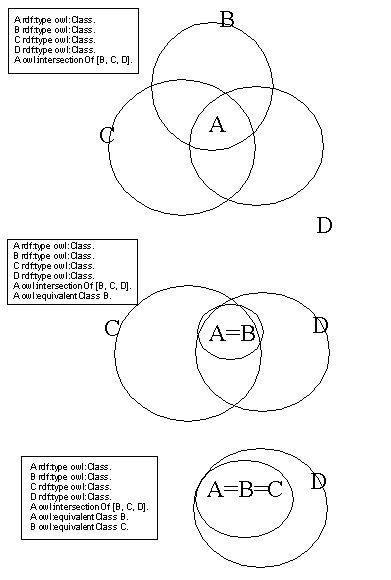- From: Danny Ayers <danny.ayers@gmail.com>
- Date: Fri, 1 Apr 2005 10:27:22 +0200
- To: Chris Purcell <cjp39@cam.ac.uk>
- Cc: Denny Vrandecic <dvr@aifb.uni-karlsruhe.de>, semantic-web@w3.org
- Message-ID: <1f2ed5cd0504010027549bb875@mail.gmail.com>
PS. Just playing with the Venn diagrams, it seems that if I add
B owl:equivalentClass C.
to
> A rdf:type owl:Class.
> B rdf:type owl:Class.
> C rdf:type owl:Class.
> D rdf:type owl:Class.
> A owl:intersectionOf [B, C, D].
> A owl:equivalentClass B.
I also get:
A rdfs:subClassOf D.
B rdfs:subClassOf D.
C rdfs:subClassOf D.
Which I must confess I hadn't expected. Does that sound right?
See attached/ http://dannyayers.com/2005/04/intersection2.gif
Cheers,
Danny.
On Apr 1, 2005 10:15 AM, Danny Ayers <danny.ayers@gmail.com> wrote:
> I /think/ I've captured the statements below in the attached diagram
> (if the attachment doesn't work, try:
> http://dannyayers.com/2005/04/intersection.gif )
>
> A rdf:type owl:Class.
> B rdf:type owl:Class.
> C rdf:type owl:Class.
> D rdf:type owl:Class.
> A owl:intersectionOf [B, C, D].
> A owl:equivalentClass B.
>
> On Mar 31, 2005 7:33 PM, Chris Purcell <cjp39@cam.ac.uk> wrote:
> >
> > > That's wrong.
> > > A owl:intersectionOf [B, C, D].
> > > A owl:equivalentClass B.
> > >
> > > can be simplified to
> > >
> > > B owl:intersectionOf [C, D].
> > > A owl:equivalentClass B.
> >
> > Unfortunately, this is not true:
> >
> > A = B = { x }; C = D = { x, y }
> >
> > intersect(B,C,D) = { x } = A
> > but intersect(C,D) = { x, y } != B
> >
> > Chris
> >
> >
>
> --
>
> http://dannyayers.com
>
>
>
--
http://dannyayers.com
Attachments
- image/gif attachment: intersection2.gif

Received on Friday, 1 April 2005 08:27:23 UTC